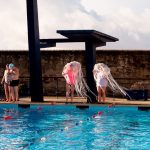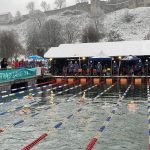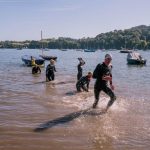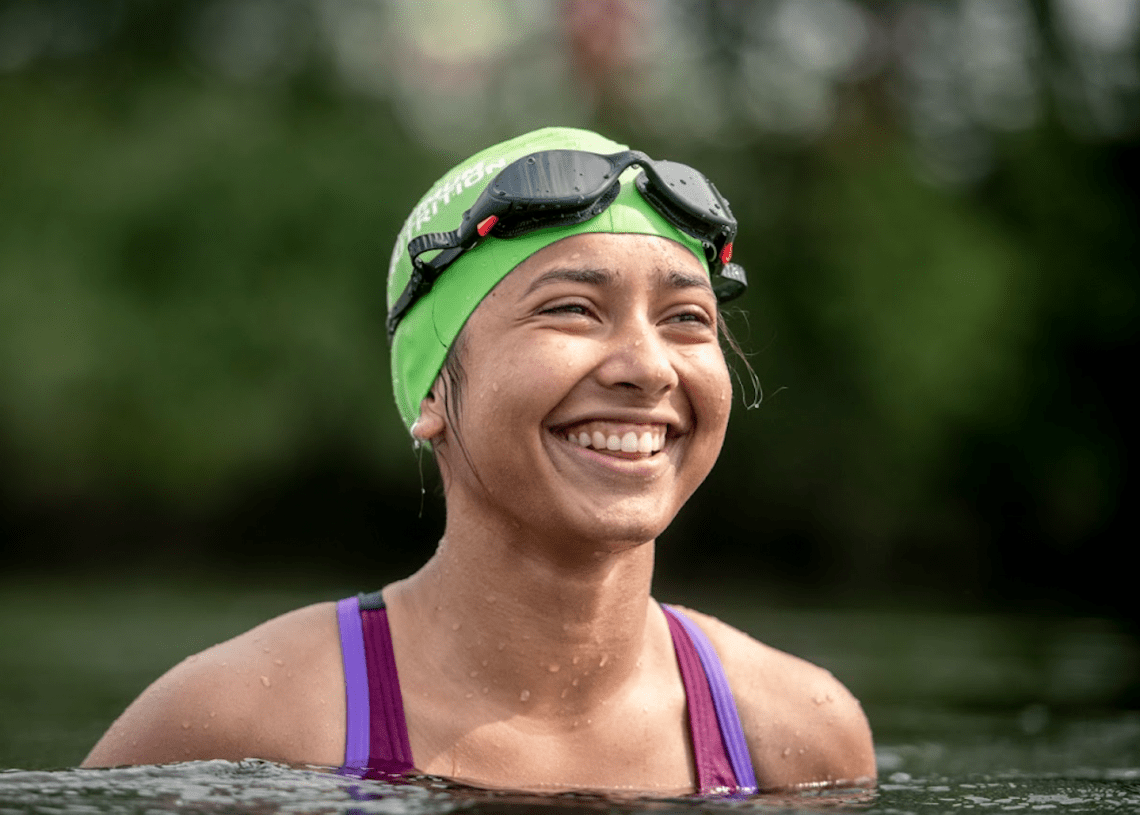
“I learnt to swim from scratch then took on an English Channel relay”
Hafsa Mughal went from complete beginner to English Channel relay swimmer, all in the space of five months. Now an open water lover, she tells us about her incredible experience being part of Optimum Nutrition’s Channel More project.
Five months ago while on holiday, beginner swimmer Hafsa Mughal had to be towed in a life ring after a bout of sea sickness and a struggle in the water. Without the life ring, Hafsa is convinced she would have sunk to the bottom. Fast forward to 30 September and Hafsa remarkably became one of five relay swimmers to cross the English Channel.
It was back in April that Optimum Nutrition launched a nationwide search for five swimmers of varying experience to part in an English Channel relay alongside Paralympian Alice Tai MBE. The selected participants then underwent a underwent a rigorous training programme created by open water specialist former Olympian Professor Greg Whyte.
The diverse group each had their own personal barriers to overcome to complete the challenge, including Alice Tai, who had to learn to swim again after having her lower leg amputated, and Tony Willis, aged 68, who lost his leg when he was eight.
Prior to applying for the project, Hafsa Mughal from London, did not know how to swim. She learnt completely from scratch before diving headfirst into Greg’s training programme and completing her leg of the English Channel relay on 30 September. The team finished the swim in just under nine hours.
We spoke to Hafsa about her incredible experience of going from complete beginner to English Channel relay swimmer – all in the space of five months.
Hafsa, how did you first hear about the challenge?
It was in the Optimum Nutrition newsletter. It said something like, “If you’re new to swimming or not a very confident swimmer, would you like to take part?” I thought that NOT knowing how to swim is new to swimming, so I might as well apply and see if I get selected.
So you didn’t know how to swim prior to applying for the challenge. Can you tell me why that is? Was it not offered to at school, or was it something you just never got round to?
Swimming just wasn’t offered to us at school. I grew up in inner city London where there are pools, but not close to where I am. And we were a single parent household on a low income. We just couldn’t afford it, so I never learned as a kid. When I went on holiday I’d think, ‘Oh, maybe I’ll have a lesson or two,’ but it would only really get me to float in a pool. I never learned anything more.
Then at the start of this year, I set myself the goal of learning to swim. So even before I’d heard about the challenge, I wanted to learn and do it in a focused way. I started having lessons once a week, then after I applied for the challenge I went on holiday for a month and everyone there basically saw me drowning. There was one trip in Italy where I was so seasick on the boat that I needed to get in the water, but I couldn’t swim. They had to put a life ring on me and tow me along.
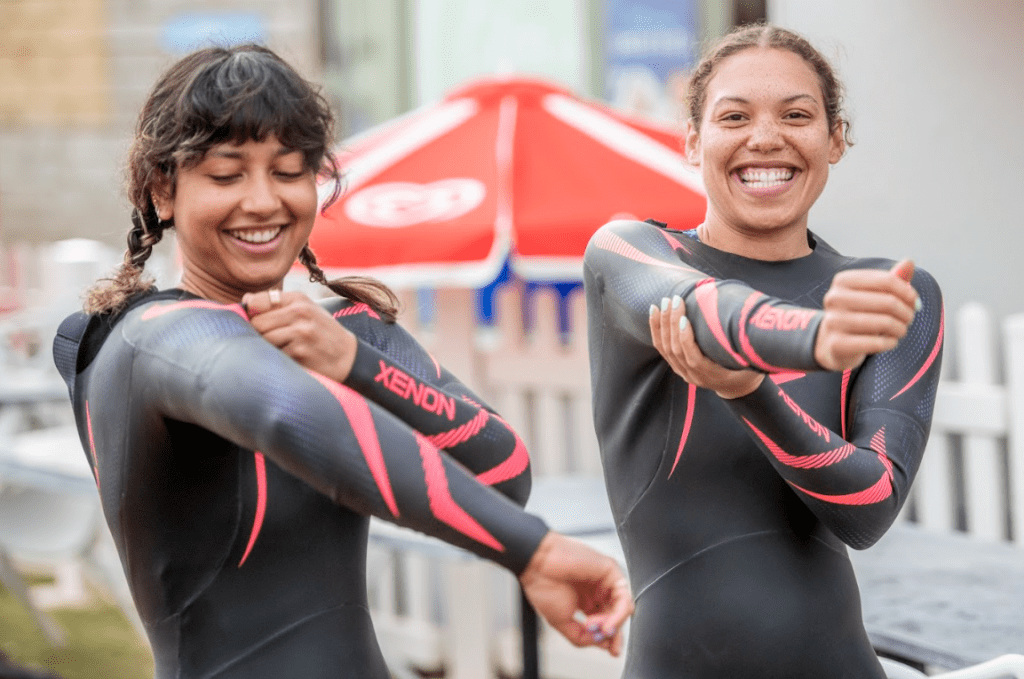
That’s quite a trajectory – going from nearly drowning to swimming in the English Channel! What made you take that leap from wanting to learn how to swim to signing up this challenge?
Back in 2015 I did a Tough Mudder. Afterwards I remember wondering to myself what the next challenge could be. Swimming the Channel came into my head because it just seemed so impossible. When I started learning to swim at the start of this year, the thought popped into my head again but I dismissed it, thinking, “That’s ridiculous, there’s no way you’d actually be able to do it.” Then when I read about the challenge it felt like too much of a coincidence not to try. And when I got picked, it was extra motivation.
Tell me about the the training, how did you get on with it?
Greg Whyte gave each of us a training programme but I was nowhere near able to do it at the start. The warm up alone was 100 meters and I couldn’t do 20. So to even get to that, Greg told to me focus on learning to swim. And then once I’d done that, to try to do as much of the programme as I could.
“The first month was about trying to swim a length on my own without wearing floaties on my arms.”
The first month was about trying to swim a length without wearing floaties on my arms. I’d say it was the last three months before the challenge that I was able to properly follow the programme. It was a mixture of sprint sessions, for example, swimming 100 meters as fast as we could, or swimming an hour non-stop and recording the distance.
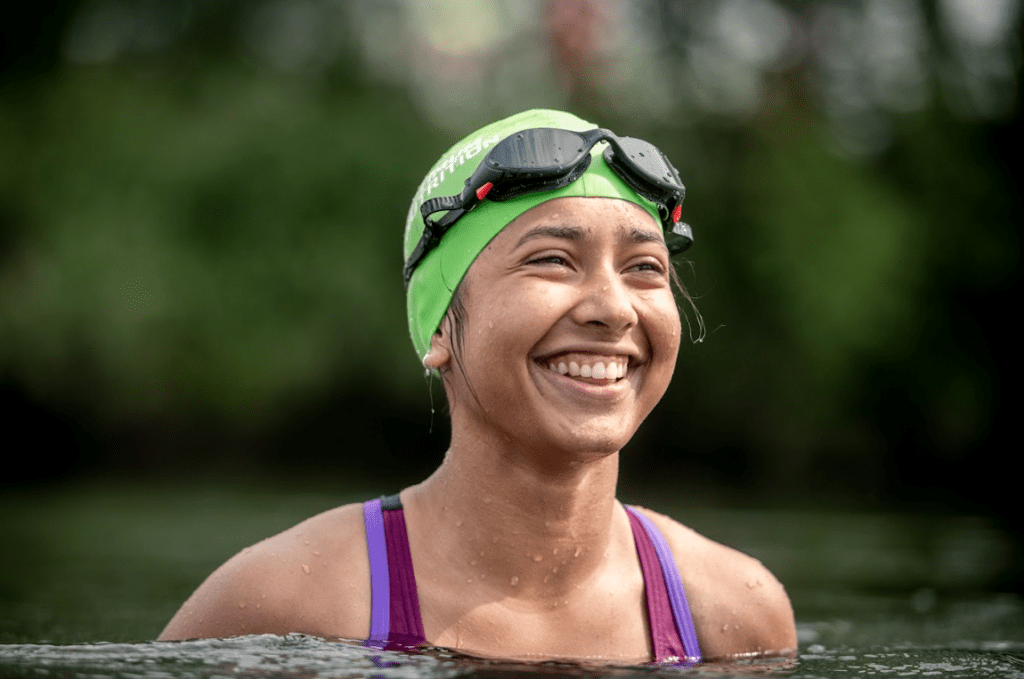
How did the training fit around your life?
I had to make a lot of sacrifices. I’d wake at 4.50am to get to the pool for 6, and train for an hour/an hour and a bit before going to work. That was four to five times a week.
Was the training completely separate from the others?
We did most of it separately but once a month we’d train together. For me, these were the most useful sessions. Our first session together was in a lake. Leading up to it I messaged our WhatsApp group asking Greg if I’d need to be able to swim in this lake session. And he replied, “It would be a bit awkward if you can’t!” So I had to really focus and motivate myself to be prepared for this first lake session. I was so scared because I still couldn’t quite believe I could swim. And if you saw my stroke that day, you wouldn’t have believed I could swim either. It was a mess.
Your confidence levels must have endured peaks and troughs throughout your training. Did you ever reach a low point where you thought that you wouldn’t be able to do the challenge?
There’s one time I’ll ever forget, when I was learning how to breathe. I just couldn’t get it. I think we’d spent three lessons focusing on it. I couldn’t complete a length without stopping. I remember tears filling up my goggles because I was so frustrated. I was thinking, “This is so simple. Everybody else gets this. Why can’t you get this? Why is this so hard? How are you going to swim the Channel if you can’t even do 20 meters?” I was asking myself what on Earth I’d signed up for and how would I ever be able to do it. That was my worst moment.
“I remember tears filling up my goggles because I was so frustrated.”
At the time, it was four months until the challenge. I said to myself, “‘Ok you can’t do this now but just keep trying and hopefully you’ll get better.” I had to say that to myself because there was nothing else. I didn’t want to give up because I’d been selected for this opportunity. But there were lots of thoughts in my head telling me, “You can’t do this, you don’t know how to do it, you can’t get something so basic.” It was a constant battle. I think in the next lesson though – I got it. Not perfect, but enough that I could get enough air so I could finish a length.
What was it that clicked for you?
Slowing down. My coach told me to swim incredibly slowly. And that was the turning point, it changed everything for me. I then got faster in that slow stroke, still being able to breathe. After that I was then able to swim just over three kilometers in one go. And it was slowing down that enabled me to do that.
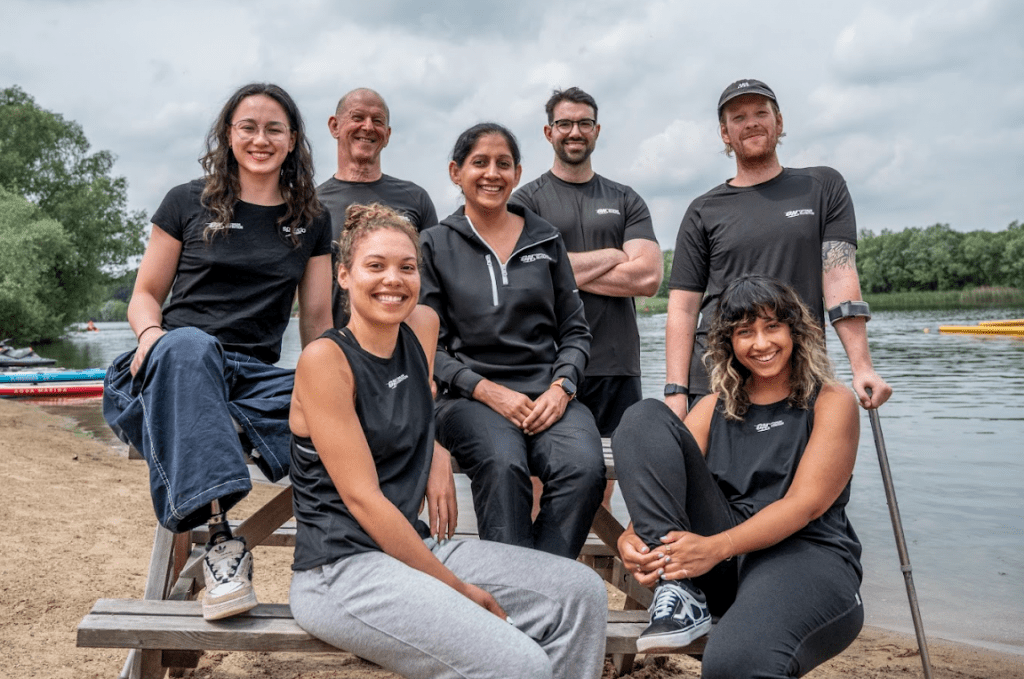
What was the camaraderie like among your relay team in your training?
Our WhatsApp group was the best. We supported each other’s milestones. And in our in-person training sessions, having everyone cheer me at the end, saying “You smashed it, Hafsa!” was really nice. I think the team was selected really well. We all got on great with each other. By the time we did the challenge we’d only met each other in person four times, but it felt like a mini swim family.
Were there any other lifestyle changes you had to make in preparation for your swim?
When I first started, my nutrition was not not right. I was so tired after my swim sessions and by around about one, two o’clock in the afternoon, my body would crash.
The sports nutritionist, Mark, told me when to start taking my supplements, and gave me more structure for when I ate my meals. His most helpful advice was for me to eat something before my swim, then have a protein shake immediately afterwards. I’d then have breakfast when I got to the office. This structure changed everything because I had consistent energy throughout the day despite the long swims in the morning and having to work until about eight o’clock at night. It sustained me, and it meant that I was able to do the training for as long as I wanted without crashing. Nutrition was critical for getting me to the Channel, and feeling physically ready for it.
“Slowing down was the turning point, it changed everything for me.”
My social life went in the toilet. I canceled all plans if they weren’t breakfast or brunch. I prioritised my sleep a lot more because I just knew that my body needed the rest to recover. My shoulders and my back were feeling it because I was using the correct muscles after I learned to use my arms, not my legs to swim.
So, how was the Channel swim?!
I was the last one in the relay round. I was very, very seasick, throwing up for five hours straight. I don’t know if it was because we started at 1am – we were going throughout the night and were all a bit sleep deprived. I must have looked terrible because everyone was saying to me, “It’s okay, you don’t need to swim, it’s fine.” But I was desperate to get into the water because I thought it would make me feel better. And also, I’d not trained this hard to not swim in the Channel. So I got in.
I don’t know if I had a fever or if it was just my brain playing tricks on me but the water felt really, really warm. Everyone else said it was cold. I remember feeling disappointed by this because I wanted the shock of the cold to help with my sickness.
“There was a lot of soothing and calming myself down to just focus.”
It sounds like a crazy thing to say but it just felt like a LOT of water suddenly around me. The water was moving in so many different directions. I just tried to calm myself down and get into a steady stroke, but I kept being hit in the face with water. The inside of my nose and mouth was burning from the salt and I was struggling to get into that rhythm.
I saw jellyfish underneath me; apparently I swam through a pod of them. I remember touching two fish, which is a very weird experience. You don’t expect to touch something in the water. You have to convince yourself to not think about it, just keep going.
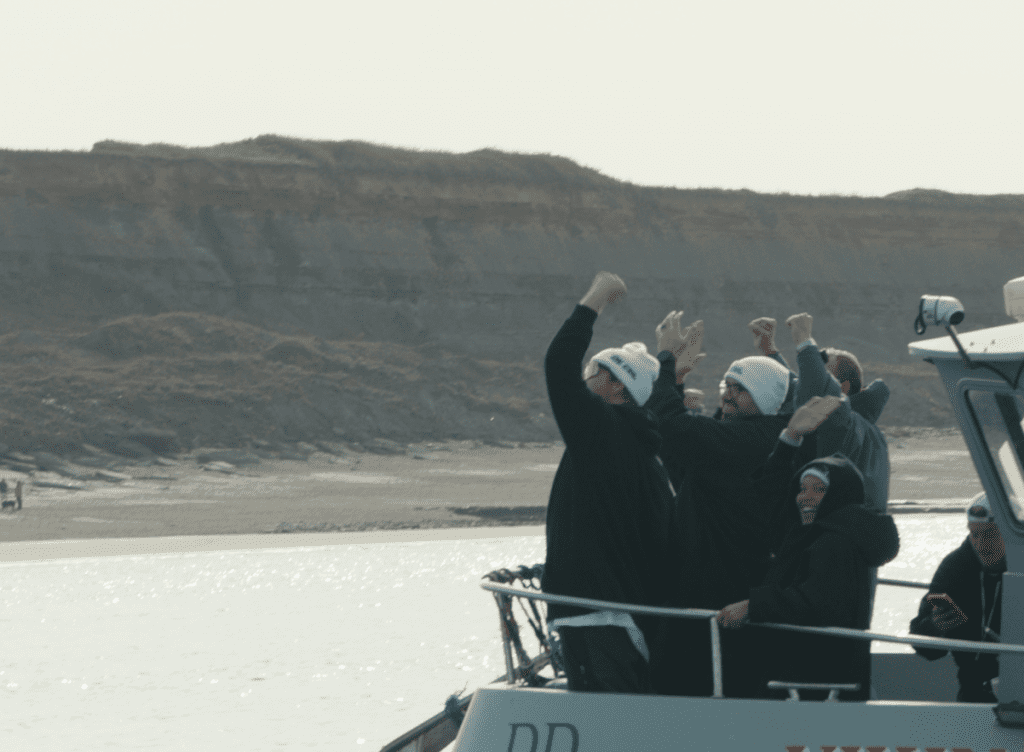
It was a lot more difficult than the sea swims we’d done in training. I don’t know if it was because it was the Channel and I knew it was THE DAY. But it felt different. I just kept trying to focus mind back to what Greg had told us – to just relax and get into a slow steady rhythm. I know that the worst thing to do in water is panic. My self talk was, “OK, you know how to do this, the next arm, the next arm, breathe, next arm, breathe.” And every time I got hit by a wave and couldn’t breathe, I’d say to myself “It’s OK, you can turn to the other side and breathe there. You don’t have to stick to the rhythm.” So, there was a lot of soothing and calming myself down to just focus.
How did it feel to reach France?
Oh, it was amazing. We were all stood on the edge of the boat watching Tony swim to the shore. When he got to the beach he pulled out a flag and we were all cheering. Then we saw this woman run up to Tony – she gave him a pebble. Apparently it’s a tradition for a local person to give the Channel swimmer a pebble to take home with them. It was unexpected, but nice.
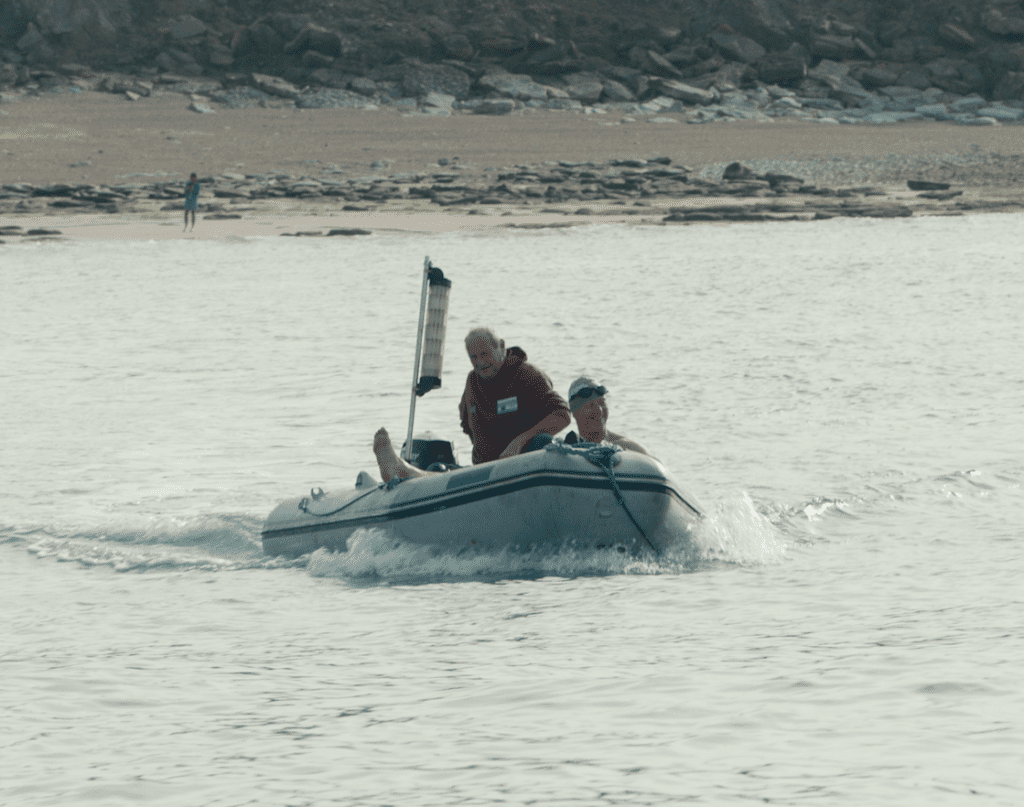
So what’s next on your swimming journey?
I want to keep swimming in open water. That’s been the surprising thing. Swimming in a pool gets boring quite quickly. Initially what scared me about open water (and what I love about it now) is that it’s endless, you can just keep going and you don’t have to stop.
When I did my 3k training in London Docks, it was a test for myself in open water. You can’t see anything; it’s cold; accidentally ingesting the water is horrible; it’s a faff to put the wetsuit on. But once you’re in there’s something peaceful and meditative about it. You forget about time and anything else; it’s all about the strokes. So I’m really grateful to Optimum Nutrition for getting me into the open water and giving me all the kit. They gave us all a wetsuit, dry robe, swimsuits, goggles, hats – all the kit to basically take away the excuses for not getting in the water. Now I have all this stuff, I want to make sure I keep using it. I’m nervous but how cold the water is getting but I’ll keep going as long as I can.
For more information about the Channel More Project, visit optimumnutrition.com/en-gb/channelmore
Read a relay team’s advice for how to prepare for an English Channel relay swim.






